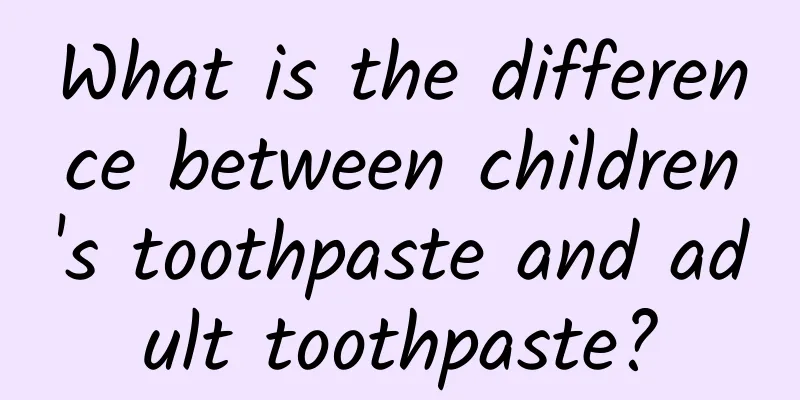What is the difference between children's toothpaste and adult toothpaste?

|
This is the 4575th article of Da Yi Xiao Hu As people's awareness of oral health continues to increase, they are more and more cautious in choosing oral health products. Correspondingly, researchers are designing these products more and more carefully. As far as toothpaste is concerned, there is a distinction between children's toothpaste and adult toothpaste. The most notable feature of children's toothpaste is its exquisite packaging and good taste. However, is the difference between children's toothpaste and adult toothpaste only in packaging or taste? If not, what is the difference? Safety of children's toothpaste As an "imported" product, although toothpaste does not need to be swallowed, it still has to interact with various tissues in the mouth, so its safety is self-evident. Especially for children's toothpaste, the safety requirements are higher. The formula ingredients and requirements related to toothpaste safety are as follows. 1. Friction agent During the brushing process, abrasives can assist the bristles of the toothbrush to achieve physical cleaning of the tooth surface and are the main functional ingredients of toothpaste. The abrasive ability of abrasives is related to its type, particle morphology and particle size distribution. Ideally, the abrasives in children's toothpaste formulas should be able to play an effective cleaning role while minimizing abrasive damage to the developing tooth surface. Given that children's toothpaste cleans deciduous teeth or newly erupted permanent teeth, the abrasive ability of its abrasives is weaker than that of adult toothpaste. 2. Surfactants During the brushing process, surfactants can make toothpaste form foam, which not only helps to moisten the tooth surface, but also allows the toothpaste to disperse in the mouth, thereby loosening and removing debris and dental plaque on the surface of oral tissue. Choosing the right type and concentration of surfactant is particularly important for children's toothpaste. For younger children, mild surfactants with less foam are more appropriate, but for older children with mixed dentition (approximately 6 to 12 years old), surfactants with more foam can be selected until they transition to adult toothpaste. The practicality of children's toothpaste In addition to safety, the practicality of children's toothpaste is also very important. The formula ingredients and their requirements related to the practicality of toothpaste are as follows. 1. Thickener Thickeners give toothpaste its shape and stability. Ideally, the consistency of toothpaste should strike a balance between being able to be squeezed out in an easily controllable manner and being able to maintain a relatively firm bond to the bristles of the toothbrush without flowing or falling off. This is especially important for children's toothpastes, where children are learning oral care skills and their manual dexterity is developing. The consistency of toothpaste affects how easy it is to apply the recommended amount (e.g., a pea-sized amount). Thickeners are often used in combination to achieve the desired effect. 2. Flavoring or sweetening agents Fragrances can freshen breath by masking bad breath and can provide a cooling or warming sensation to the mouth during and after brushing. Fragrances can also mask the taste of other ingredients in a toothpaste formula. Children and adults of different ages have different sensitivities and preferences for different basic tastes (salty, sweet, bitter, sour). The design and development of flavors for children’s toothpastes should take these physiological differences into account, while also considering factors such as flavor type, flavor intensity, sweetness level, and the ability to mask the bitter taste of any ingredients in the formula. The flavor design of children's toothpaste is aimed at encouraging children to develop oral health habits. When choosing toothpaste for this purpose, parents should follow the children's own preferences because they cannot accurately understand their children's taste preferences. Although toothpaste is small, it has a lot of knowledge. Now you know the difference between children's toothpaste and adult toothpaste? In short, it is safe and easy to use. Author: Fu Rao, Shanghai Health and Health Development Research Center |
>>: "Fatal" acute epiglottitis
Recommend
Why does a woman's lower abdomen hurt when pressed?
Why does it hurt when pressing the lower abdomen?...
Snapchat CEO: 70% of users are women
Snapchat co-founder and CEO Evan Spiegel Evan Spi...
What can a woman eat to get rid of spots on her face?
With the gradual increase of age, many dark spots...
What is the reason for leucorrhea like tofu dregs
Leucorrhea can be regarded as the main secretion ...
What is the protein content of bean sprouts? Why do bean sprouts turn green?
Bean sprouts are white, tender, refreshing, beaut...
What are the symptoms of acute pelvic inflammatory disease?
Compared with chronic pelvic inflammatory disease...
What's wrong with irregular menstruation?
Many women will face the problem of irregular men...
Do you know? Open the door | Women must know about HPV!
Expert who wrote this article: Liu Jiang, nationa...
Can I take Dragon Blood Dried ...
Blood stagnation often occurs in female friends. ...
Olive oil has unimaginable effects on women, but 90% of women don’t know it
Women all like to take care of themselves. Olive ...
Can I eat pig intestines during menstruation?
Menstruation is a very different period for women...
What are the feet of a snail called? What are the teeth of a snail called?
Snails are a group of animals that include many d...
What is the reason for the sudden heavy menstrual flow during menopause?
When women reach menopause, they will experience ...
What is the pregnancy rate of a double uterus?
I believe that many people are not very familiar ...
Causes of Candida infection in women
Many bacteria in nature can cause certain harm to...









